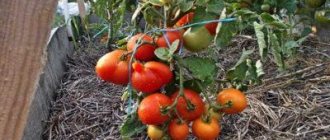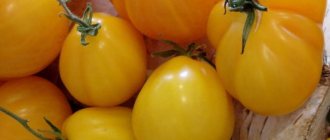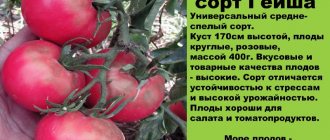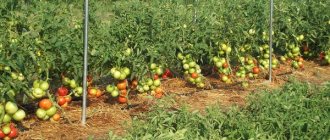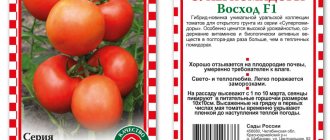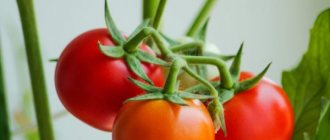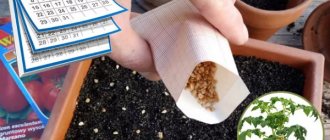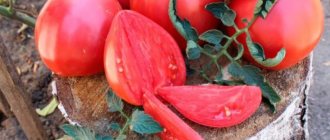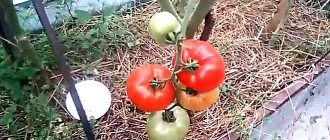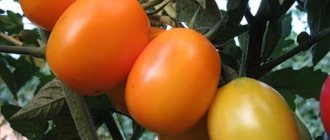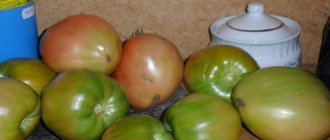Tomatoes: advantages and disadvantages
Since the variety is a hybrid, through selection at the genetic level it has many advantages over many other tomatoes. The main advantages of the Anastasia variety:
- Ease of cultivation;
- Rapid growth and adaptability to environmental conditions. Tolerates temperature changes well, feels normal even with a lack of moisture in the ground;
- Not bad immunity;
- High level of productivity. Even on infertile soils they are able to produce a decent harvest.
The disadvantage is that it is demanding in tying up the bush, even with its small growth. This is because the fruit clusters are very heavy and can break off.
Description
According to the period of fruit ripening, tomato "Anastasia" belongs to the representatives of early hybrid varieties. The biological maturity of the vegetable occurs 100-105 days after the appearance of the first shoots. The variety is intended for planting in open ground, as well as in a greenhouse.
Tomato bush "Anastasia" is determinate. The height of an adult plant is only 70 cm when grown in open ground and 90 cm when grown in greenhouse conditions.
Important! Due to the small size of the bush, this variety of tomato does not require pinching, which greatly facilitates the work of the gardener in the process of growing tomatoes.
The fruits of the Anastasia tomato variety, as you may have noticed in the photo, have a round shape. In the biological maturity phase, vegetables are red in color. The weight of one tomato is 100-110 grams. The fruits are fleshy.
The productivity of the variety is high. 5-6 tomatoes grow on a bunch. From one square meter of sown area you can harvest up to 25 kg of vegetables.
In cooking, tomato is used raw, for preparing vegetable salads, as well as for canning and preparing preparations for the winter.
Growing tomatoes
Growing tomatoes is not a very complicated process, which is discussed below.
How to prepare seeds?
An important point in growing tomatoes is preparing the seeds before planting, especially if the material is not purchased in a store, but collected with your own hands. The preparation algorithm consists of the following actions:
- Sorting. Eliminate diseased or unusable material before planting. The procedure can be carried out using a solution of salt water and the seeds unsuitable for growing will float to the surface.
- Disinfection. In order for healthy bushes to grow, the seeds must be disinfected. For example, soak for half an hour in a weak solution of manganese.
- Germination. To know exactly which seeds will grow, you can germinate them on a damp cloth (gauze) before planting.
Sowing seed material
For sowing you will need:
- Containers. You can prepare small plastic cups;
- The soil. The mixture can be bought in a store, or made with your own hands from fertile soil, turf soil, humus and sand.
Seeds are carefully placed in prepared containers with soil to a depth of 1 cm and lightly crushed with soil. Then water it with a spray bottle and place it in a brightly lit place.
Rules for planting seedlings
Seedlings are planted in the second half of May. Planting pattern 50 cm by 60 cm.
IMPORTANT: A solution of copper sulfate is added to the bottom of the holes to prevent diseases.
When planting, you need to immediately dig in pegs to tie the bushes.
Features of cultivation and care
The process of growing and caring for the Anastasia tomato variety consists of sequentially performing certain stages.
Initially, seeds are sown in the ground. After the first 2-3 true leaves appear on the seedlings, the plant is pruned. The picked bushes are placed in a well-lit and warm place for further growing of seedlings.
Advice! Tomato seedlings need careful care. It needs to be regularly watered, fertilized, and turned 1-2 times towards the sun to prevent the main stem from bending.
Planting seedlings in the ground or greenhouse must be done after the spring frosts have subsided. It is best to carry out the planting procedure in preheated soil so that the seedlings experience minimal stress during planting and develop better in the future.
Subsequent care for the Anastasia tomato variety consists of regular and timely watering of the plant, weeding and loosening of the soil, especially after watering and fertilizing.
Advice! When growing tomatoes in greenhouse conditions, to prevent the appearance of late blight and rot of leaves and fruits due to high humidity, the soil should be mulched.
Dry grass clippings are ideal as mulch.
To obtain a rich harvest, as well as to extend the fruiting period, it is necessary to timely and regularly (at least 1-2 times a week) collect tomatoes that have reached their biological maturity.
Reviews about the variety from those who planted
Many positive reviews about the variety confirm that “Anastasia” bushes are unpretentious, very productive and tasty. Gardeners also note high resistance to various fungal diseases.
Sprouts must be hardened off before being planted in a permanent location. To do this, it is recommended to take the pots out onto the balcony or outside every day for a couple of hours during the week.
Therefore, from the article we can conclude that the variety has many advantages and minor disadvantages, so by choosing it, the gardener will be satisfied.
Planting in open ground
The timing of planting seedlings in open ground may vary depending on the climate. Residents of the middle zone can start planting seedlings in the second half of May. Moreover, it is better to do this in the evening or in the morning.
Site preparation
It is recommended to start creating beds a week before planting seedlings. However, before this it is necessary to prepare the land. A solution of copper oxychloride or copper sulfate is added to it in advance. It is not recommended to use too much fertilizer. A liter of fertilizer will be enough for one square meter of land.
Organic and mineral fertilizers are also added to the soil. 4 kg of peat, sawdust, and humus are added to the soil. After this, the area must be carefully dug to a depth of about 35 cm and leveled with a rake. To disinfect the soil, the entire area under tomatoes is watered with hot water.
Landing
Seedlings are planted in the ground in a vertical position. In this case, the stem should be above the ground, and only the roots of the bush go deep into the soil. It is recommended to plant young seedlings in two rows. The distance between them should be about 50-60 cm.
Immediately after planting all the seedlings in the ground, you should begin installing the stakes. They will serve as a support for staking the plants. The height of each peg should be about one meter. If the bushes are too tall, you will have to install larger supports.
Diseases and pests
This variety is not susceptible to fungal diseases. A tomato can “get sick” if basic preventative measures are not taken.
To avoid such problems, when cultivating, you must regularly ventilate the room where your tomatoes grow and prevent the soil from drying out or becoming waterlogged. Sudden temperature changes will not harm this species, but it is still worth monitoring the lighting and temperature in the greenhouse.
IMPORTANT! In the middle zone, slugs can cause great damage to these bushes. They are fought by removing excess tops and isolating the soil, creating an unbearable environment for their habitat.
Also a good measure of protection would be coarse sand, ground nut shells or eggs; they need to be scattered around the plants to create the necessary barrier. A frequent uninvited guest in a greenhouse or greenhouse is the melon aphid; the drug “Bison” is also used against it. Like many other varieties of tomatoes, they can be attacked by the greenhouse whitefly; they fight it with the help of the drug “Confidor”.
As you can see, this is a fairly easy-to-care variety; if you follow simple care rules, you can get a very good harvest. Good luck to you and a delicious harvest on the site.
Tomato "Anastasia": a lot of advantages and easy cultivation
For many gardeners who do not have their own greenhouse, but want to quickly grow a tomato crop, there is the Anastasia variety. It is resistant to sudden changes in weather and also has good immunity to disease. This article will be useful for those who plan to plant Anastasia tomato; characteristics, description of the variety, reviews, photos, yield are given below.
Farmer reviews
Let's see what experienced farmers and beginners say about the Anastasia variety.
Oleg, Vladimir: “On my plot every year I grow 4-5 different varieties of tomatoes.
I can say that Anastasia is my favorite tomato. It grows well in the open air and does not get sick. For the best harvest, I fertilize it with liquid mullein and humus. It ripens gradually, the tomatoes are sweet, the taste is excellent.” Mira, Rostov region: “I learned about this variety not so long ago and decided to try planting it in my garden. I can't say that he impressed me very much. The seed manufacturer promised large tomatoes, but the maximum weight I got for one was 90 g. The taste was bland because it rained a lot. I don’t know if I’ll grow it again.”
Svetlana, Saratov: “I love hybrids because they rarely get sick. I’ve been growing Anastasia for the third year in a row, and I’m happy with the harvest. Of course, the variety is inferior to those hybrids that do not need garter. Otherwise, the vegetables fully correspond to the stated description.”
What is an Anastasia tomato?
Tomatoes can be harvested within 100 days after the seeds have been planted. In greenhouses, tomatoes ripen a little faster.
Among the main characteristics contained in the reviews of summer residents are:
- in open ground conditions, the bushes grow up to 0.7-0.9 m, so they must be tied up so that they do not break under the weight of the fruit;
- To increase the yield, pinching is carried out, although Anastasia tomatoes even without this process are distinguished by a large yield;
- During ripening, the fruits first turn green and then burgundy;
- the weight of 1 fruit is 130-180 g;
- up to 20 kg of tomatoes are usually harvested from 1 m²;
- many clusters are formed on the bushes, on which several tomatoes ripen;
- the fruits have a plum-like shape and small size.
When describing the variety, it should also be noted that the yield is not affected by the condition of the soil. It may contain a small amount of minerals and nutrients, and the bushes will still bear fruit. Anastasia tomatoes do not require special care; it is enough to water them regularly.
If there is little moisture in the soil, the plants will cope with this problem on their own. Therefore, it is profitable to grow the variety in regions where there are constant fluctuations in temperature and climate.
See also
Description of the Natalie tomato, cultivation of the variety and planting rules
Read
Tomato variety “Nastya F1”
The Nastya F1 tomato variety is an early variety, since from the moment of planting to the ripening of tomatoes it usually takes from 90 to 95 days.
The bushes are standard, indeterminate, their growth is from 1 to 1.1 m, in the south in greenhouses they sometimes grow up to 1.3 m. The yield is quite high both in unprotected soil and in greenhouses. It is characterized by average resistance to diseases such as root rot, late blight and brown spot. Careful care and frequent feeding allow you to collect from 2 to 2.5 kg from each bush. For 1 sq. m three or four plants are planted. It turns out about 8 kg per 1 sq. m, while in the south this figure sometimes reaches 10 kg. This yield can be called high. The peculiarities of the variety include a peculiar sweet taste. Many people also like the small size of the fruit. In addition, the friendly ovary and high ripening rate deserve attention. Ripe tomatoes have a bright red color. The shape of the fruit is an ordinary small cherry, characterized by a slight elongation. The skin is quite dense and glossy, and the flesh is flexible and fleshy. The taste properties are quite high, the taste is typical of cherry.
Advantages and disadvantages
Advantages of the Nastya tomato variety:
- pleasant sweet taste;
- small fruit sizes;
- suitability for prefabricated canning;
- unpretentiousness to weather and soil;
- long shelf life;
- high resistance to diseases.
The disadvantages include the need for pinching, tying up the trunk and supporting the branches.
Features of care
The trunks need to be strengthened with trellises or sticks. Brushes need support. The shoots need the first garters at the moment when the growth of the bush reaches 20 cm. If this variety is planted in a greenhouse, the formation of the bush occurs in 2 stems, and in the case of cultivation in open soil - in 3 stems. The soil does not require special preparation, since this variety is unpretentious to the soil. At each stage of growth, good responsiveness to natural and synthetic fertilizers, as well as growth stimulants, is noted.
In addition, when growing in greenhouses, it is important to constantly ventilate the room in which the tomatoes are grown and to avoid drying out or excessively moistening the soil. It is imperative to loosen and mulch the soil properly. Sharp temperature fluctuations do not harm this variety, but you need to pay attention to lighting and temperature in the greenhouse.
Pest and disease control
Despite the good immunity of the Anastasia hybrid, gardeners should pay attention to compliance with the requirements of agricultural technology and preventive treatments of plants. A tomato bush gets sick when it is weakened or unprotected. To prevent infection from occurring, you need to promptly:
- regulate the frequency and abundance of watering;
- control the level of air and soil humidity in the greenhouse;
- mulch the beds;
- inspect the plants.
Most often, symptoms of VTB or late blight appear on tomatoes of the Anastasia variety. At the first signs of the disease, you need to use saltpeter, Bordeaux mixture, copper sulfate, Topaz, and immediately remove infected plants.
Among the pests, slugs (ash will help), melon aphids (preparation “Zubr”), and whiteflies (“Confidor”) are considered dangerous.
Harvesting and application
Anastasia is collected as it ripens. Sometimes the bushes contain rich dark red tomatoes that are not yet ripe at the stage of milky ripeness. After collection, it is recommended to store them in wooden boxes, cover the top with paper or a lid.
Tomatoes are used to prepare various dishes. The taste of the hybrid is perfect for pizza, julienne, salads and vegetable stews, and tomato juice. Tomatoes are also eaten fresh.
Tomato variety PHOTO your reviews!
Lyudmila
Photo of my tomatoes, I’ve been sowing for years…. Well, more than a dozen. They gave me a brush with tomatoes. She called it "Grapes". The description fits these cherries completely. I plant 2-3 bushes together at the outermost ones at the entrance, we also call them “guest”; whoever looks into the greenhouse tries it. They bear fruit for a very long time and are sweet. I planted it outside, no leaves visible, just brushes. And this is here in Siberia. I think the old variety has a new name.
Dashulka @ [email protected] Albu
oh these tomatoes are so delicious... In fact!!!! this is a personal comment from me... and here’s another interesting review
One and a half hundred - from the bush I was very interested in the Sweet Cherry tomato, which has up to 50 fruits in the cluster. It didn’t work out for two years, but I still managed to cope with it. I got almost 500 fruits from three bushes. Now this variety is in my place of honor. I grow it through seedlings. I plant the plants on the south side, near the chicken coop (it protects from the north wind). I prepare a bed for tomatoes in late March - early April. I take out all the soil, pack the manure tightly (we keep the goats), pour hot (almost boiling water) water on it and return the soil to its place. A few days later, I plant the seedlings and cover them with film, and if frosts are expected, then in two layers and with old blankets. Sweet Cherry grows quickly, begins to bloom and ripen early, and produces a harvest for a long time, almost until frost. The first bunches have 10-12 fruits, the last ones have 17-23 pieces. V. Zakharova
Dmitriy Samsonov
instead of grapes
Mikhail Fomichev
So-so, the size of a cherry. They do not ripen at the same time, and what to do with them? If you make a salad, you will be tortured to cut it. In general, it is an ornamental plant.
Irina Voloshina
I don’t know about Tomato, but the company is a scammer, a waste of money and time. Tested more than once.
rrr
grown last year... there were 5 times more greens than tomatoes)))... they grew 6-meter-long fools, the seeds were French
New day
This is not a variety, it is a hybrid. if you want a lot of small tomatoes - sweet and with a long fruiting period - plant Honey Drop. There is a tested hybrid - Red Caramel, which is also good. I can’t say anything about this hybrid - I haven’t planted it.
Tatiana Tsivilskaya
! These are my. You can plant several bushes. . In general, I'm not happy with cherry tomatoes. Just fancy tomatoes. . Picking is tedious, like berries. I preserve it beautifully with the stalk. But for some reason everyone eats better than normal people. . My son says, I feel sorry for these kids... The decoration is good, but there are so many of them growing. . So much is not spent on decoration... They ripen unevenly, that's for sure. . I will plant no more than 2 this year...
Leon
I raised people like this no more, they took up a lot of space, they stretched out over two meters, but what’s the point…. pampering!
Svetlana Butorina
For “forage” I like it; I plant several red and yellow bushes. Whatever is left uneaten, I roll it up into small jars, and the jars are handed out to guests as gifts.
Natalya Danilova
good pampering
Rukhshod Dadomatov
This is Tomati Cherry
Tanya
One year of planting is probably enough, everyone writes correctly - for pampering))))
Lyudmila Gypsy
This year I also had slightly different “Golden Brush” cherries, but that was okay, I really liked them and there were a lot of fruits.
Svetlana Burova
there should be a lot of everything in the greenhouse
Lina Sakharnova
In my opinion: The only use for any CHERRY is freezing to decorate pizza!! ! How much do YOU freeze?
How to grow tomatoes
After the seedlings have sprouted, proceed to the stage of transplanting the plants into the ground.
Landing
Prepare the beds before planting.
They must be clean, free of foreign debris and other plants. It is recommended to dig up the soil in the fall and loosen it in the spring. Also make sure that the soil does not contain remnants of previous diseases. A week before planting, it is recommended to add mineral and organic fertilizers to the soil. For example, add sand and peat, and then level the soil with a rake. For disinfection, it is recommended to water the beds with hot water.
As soon as the beds are ready, proceed to transplanting the sprouts. The holes should be located at a distance of about 40-60 cm from each other. Place the sprouts in them with lumps of the old soil on the roots. When you plant the bed, water the soil with warm water. Make sure that water does not get on the leaves. It is better to plant tomatoes in the morning or evening.
Important! The final stage of planting is the installation of pegs that will serve as support for the bushes. The height of each must be at least 1 m.
Care
It is necessary to water the bushes every 5-6 days. Pay attention to weather conditions as well. If it rains frequently, reduce the amount of water. If it's a hot and dry summer, increase it. The main thing is to remember that excess moisture leads to cracking of the fruit and the development of many diseases.
Important! The Anastasia variety is not protected from the formation of stepsons. Remove shoots carefully so as not to damage the remaining stems. Some gardeners recommend doing this with gloves.
Remove weeds periodically.
To create the best conditions, cover the beds with dry leaves. Also, do not forget to loosen the soil every 7-10 days. As soon as the fruit begins to set, tie the stems to the stakes. Otherwise, the branches will break under the weight of the vegetables. Don't forget about applying fertilizers. The first feeding is carried out 10 days after planting. The hybrid responds well to fertilizing based on ammonium nitrate, potassium salt, and other nitrogen-containing substances. Ordinary organic compounds, such as humus and liquid mullein, perform well as fertilizers.
Features of cultivation and possible difficulties
It is also necessary to tie up the Anastasia variety so that insects do not feast on fruits that come into contact with the ground. In addition, the garter provides the tomatoes with air ventilation between the bushes and convenient watering of the plants.
In addition to pegs for garter, you will need ribbons. It is best to use synthetic material, as it does not rot, which means it attracts less insects. It is better not to use ropes and wire for garters.
If Anastasia's leaves become dry and turn yellow, it means the plant lacks magnesium. A solution of Epsom salts or magnesium nitrate will help correct the situation. If the leaves have a pinkish tint, the bushes do not have enough sulfur. Replenish its deficiency with magnesium sulfate.
Diseases and pests
Among insects, the hybrid is most often attacked by wireworms. It penetrates the root system and destroys the roots of the bush, eating them. As a result, the bush dies, and the wireworm moves to another plant. There is also another pest called whitefly. This small insect looks similar to a white moth. The whitefly attacks the tomato in a flock, sits on the leaves and feeds on them. Spraying with whey or garlic solution helps get rid of pests.
Of the diseases, the worst enemy of all tomatoes, late blight, deserves special attention. It appears as brown spots on the leaves, which are very difficult to get rid of. The hybrid can also get blackleg. This fungus appears as a result of soil contamination and penetrates the weakest stems. To prevent it, it is recommended to monitor the light and watering regime and loosen the soil.
